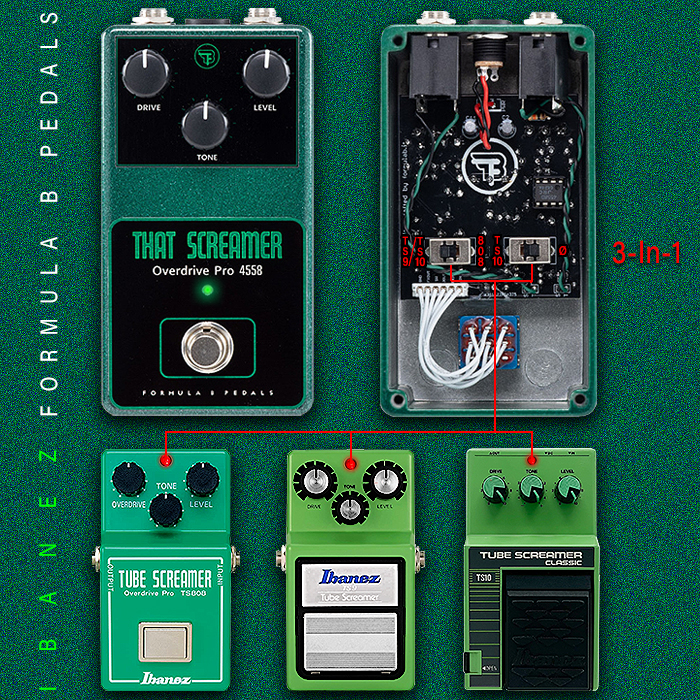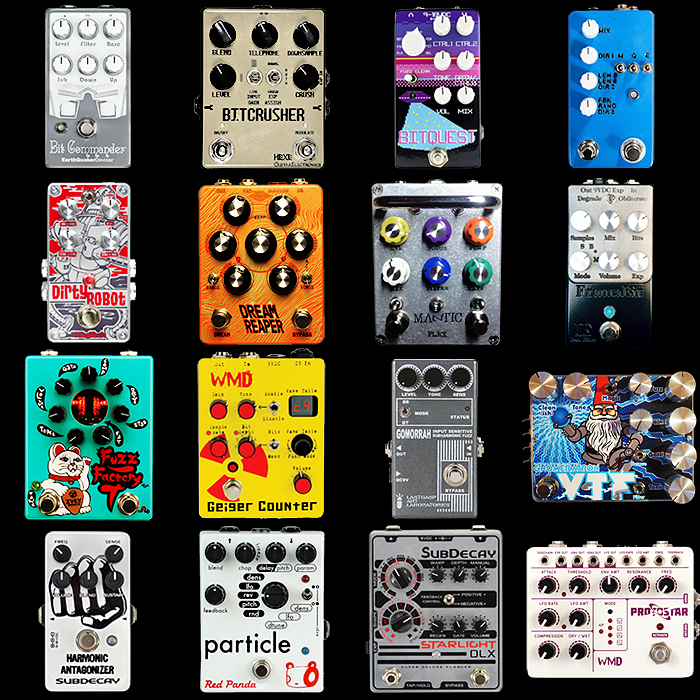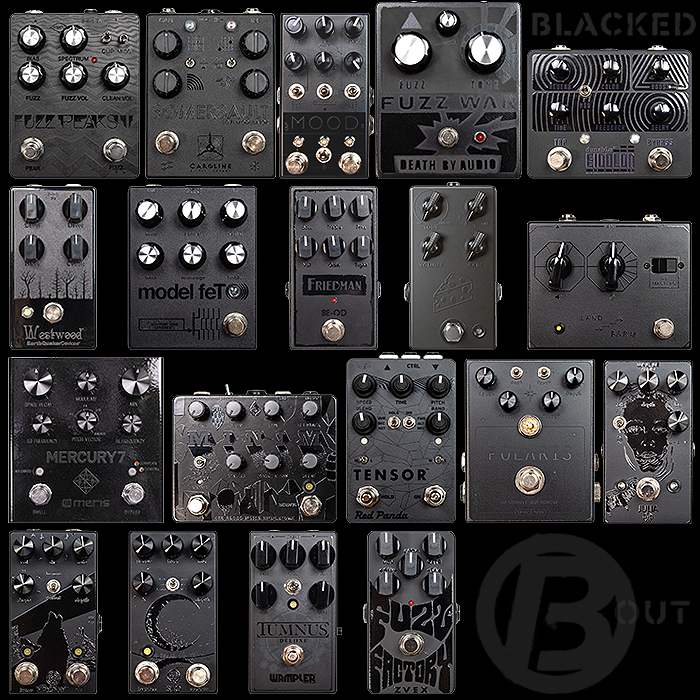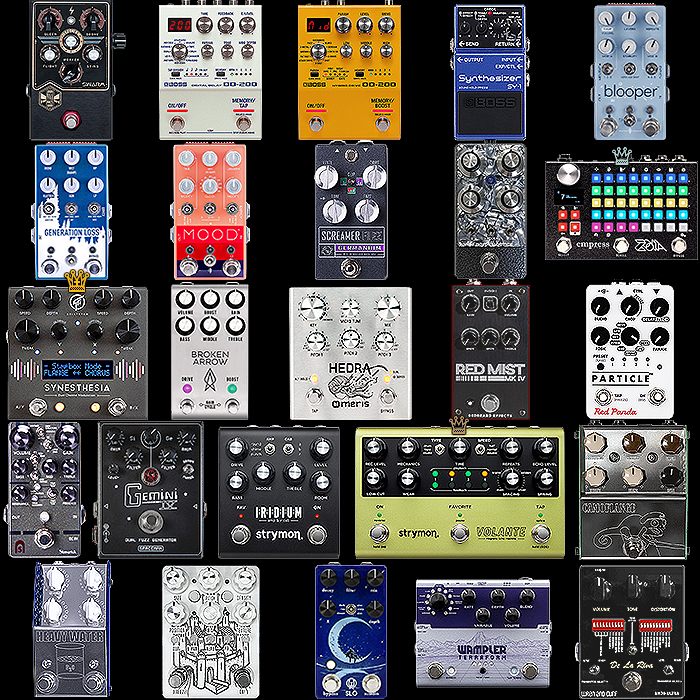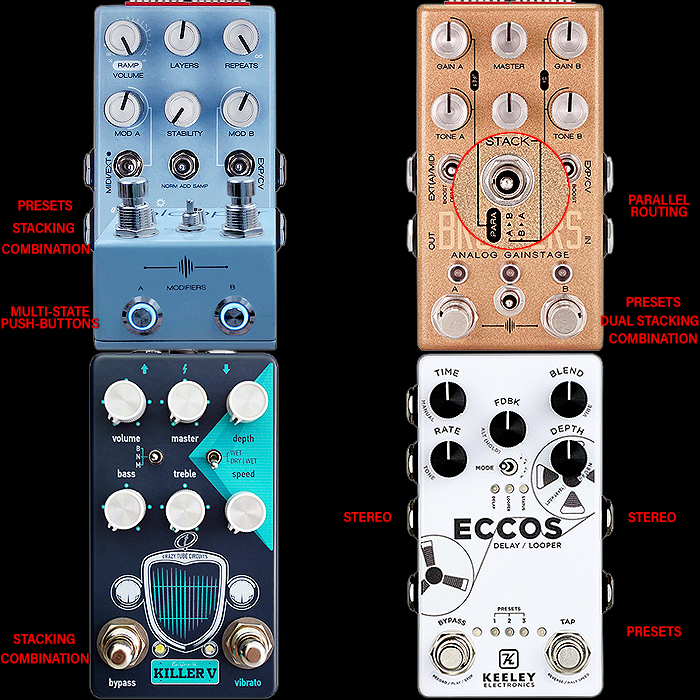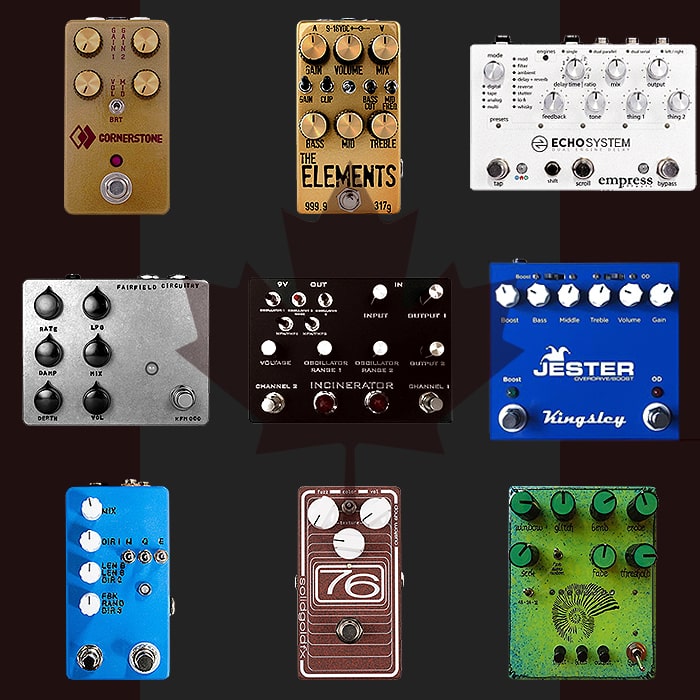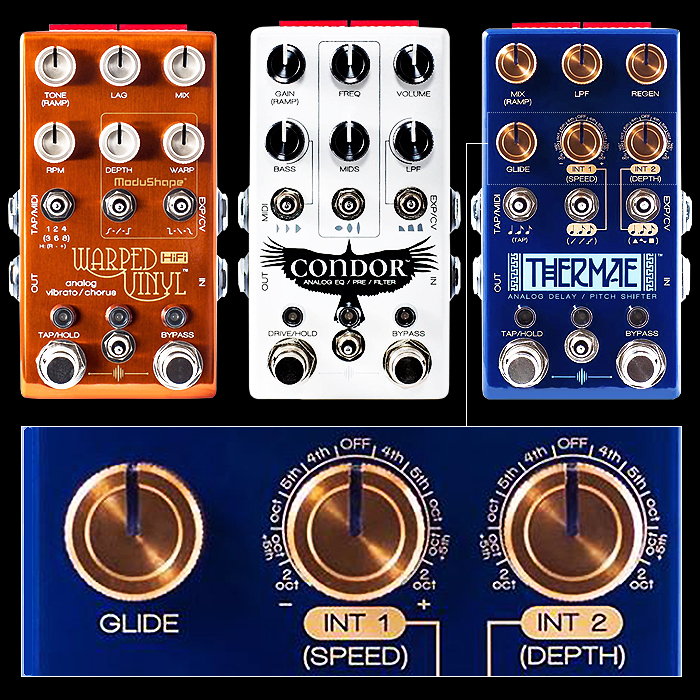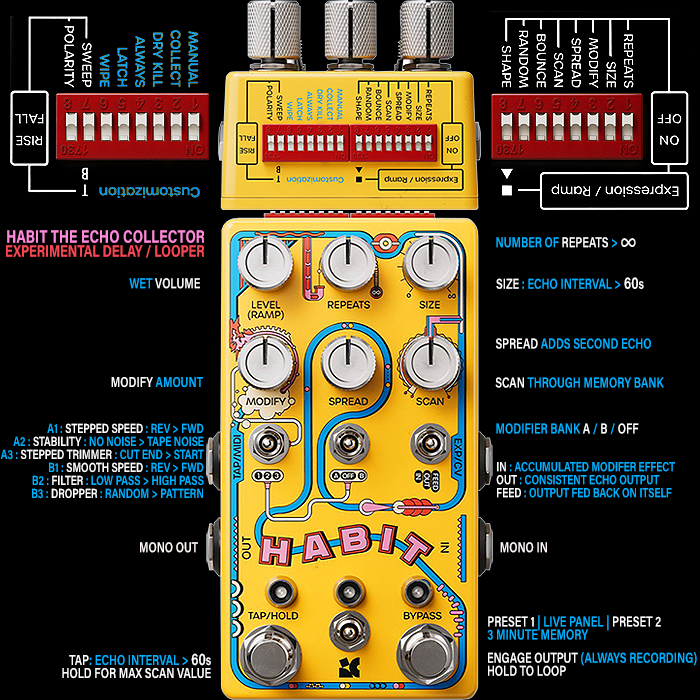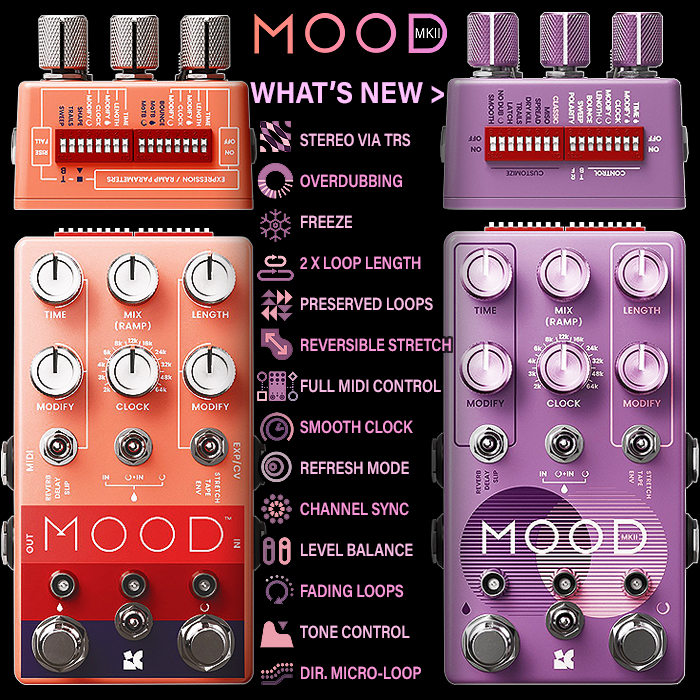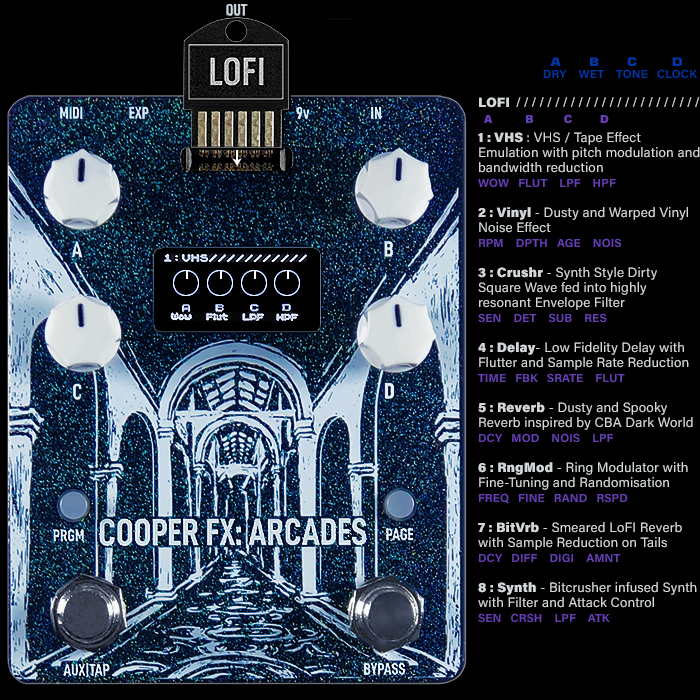2019 Year of Glitch - Final Overview and Impressions

As mentioned several times throughout this year - this was supposed to be my ’2019 Year of Glitch’ (which actually covers a number of sub-categories) while in reality I was rather more widely actively engaged than that - and still somewhat carrying on with 2018’s Year of Fuzz theme - various pedal-chain upgrades and all my usual random tangents!
When I started the initial campaign over a year ago now - I believe I was on the brink of or had just acquired the first of my ’Glitch’ pedals - The King of Gear Mini Glitch. Of the initial 16 pedal target selection I set out, I have acquired just 5 - but then this has evolved and become a somewhat moving target with different target selections in the mix throughout the year.

I was looking at acquiring a Cooper FX Moment Machine at some stage - probably the most complete Pitch-Shifter on the market to-date, but when the Meris Hedra arrived and I acquired one such, I kind of decided that the vertical medium enclosure form factor was as much real-estate as I wanted to allocate to 'glitch' effects in my chain. My extensive 41 pedal chain doesn’t allow for a lot of size-flexibility - in particularly since I swapped in the admittedly excellent ThropyFX Camoflange. I was also initially chasing down the slightly larger form-factor Pladask Elektrisk Form 2 - when I decided that the rather neater Fabrikat would probably be more my style - so lots of things chopped and changed throughout the year.
Also after placing an order for a second batch Tomkat Cloudy on May 28th and having to wait until the end of November for the arrival of that - that obviously impacted the process somewhat - holding up my acquisition of other like pedals, and I still haven’t had much opportunity to really go to town on the Tomkat Cloudy yet.
Most instructive this year was my very detailed and exhaustive review of David Rolo’s V3 Molecular Disruptor - which caused me some degree of frustration over the many weeks I ran that through its paces. A great number of ’Glitch’ pedals have as many as 8 or 10 properly 'interactive dials' - meaning that like the Zvex Fuzz Factory - you cannot really adjust individual dials one-at-a-time, but need to adjust several in concert simultaneously. Hunting for sweet-spots on a particular algorithm (There are 16 on several of these pedals) can take a whole day / afternoon of finely tweaking and calibrating each dial in coordination - and despite how great you get your output to sound and how detailed your calibration notes are - you still very much need to do some final tweaks when trying to dial in those settings from your notes a second or further time.

I realised fairly early on in the process that most Glitch effects aren’t really properly mass-market ready yet. Or at a stage where you might expect to see Boss or Strymon bringing out their own Granular / Glitch pedal representatives. The state of the art currently is that these innovative builders are still tweaking the formula - and trying to figure out the best / least number of controls necessary to arrive at the sweet spots and the ease of recalling or replicating those. For me the only logical path here is onboard presets - which is why the only pedals in my current selection that I can truly 100% recommend to all are those which have some form of onboard presets - and this includes a relatively small group of Chase Bliss Audio (2 Presets each) and Red Panda Particle V2 (4 Presets).
Of my now probably final target list of 16 as per the top image - where I’ve discounted a fair few along the way and/or found others that I prefer - I currently have acquired 11 - with the Chase Bliss Audio Blooper set to land this coming Thursday 19th of December - most likely my last pedal arrival before Christmas. I had the Banana Effects Mini Mandala in my sights, but dithered and chased after something else - to such a degree that it was sold out by the time I got around to it again - but that is definitely still on my acquisition list - now for 2020 (actually due back in stock December 26th supposedly), along with the CBA Dark World, Hexe reVOLVER DX, Red Panda Tensor and SSD Devices Atom Smasher.
The CBA Dark World famously has Tom Majeski of Cooper FX’s glitchy algorithms on the left-hand-side - based on his Generation Loss and Outward pedals to a degree. CBA generously released their own compact version of the Generation Loss also this year which run I was lucky to be in on. The Hexe reVOLVER is relatively pricey and in rare supply - so I will bide my time for that on Reverb.com (or may still order direct) - same goes for the actually fairly relatively recent SSD Devices Atom Smasher Glitch Delay where said Maker is currently on extended leave / hiatus from the business. For the Red Panda Tensor I will likely wait for its follow up version to arrive at some stage - with onboard presets hopefully. Every one of these pedals really needs presets for sure considering how long it can take to dial in those sweet-spots and manually replicate!
Pedals are listed alphabetically by brand, and range from c£150 to c£400 - especially when factoring in delivery and customs charges from abroad! :
Banana Effects Mandala 8 Mode Glitch Pedal - £189
I've only just featured this in a couple of recent Mini Pedal overviews - where I actually stated my desire to own all 4 of Banana Effects Mini pedals - I was all set to acquire this one a week ago - but they'd all gone out of stock by then - possibly because of my own feature article! In any case a really cool 8-mode glitch pedal with the following algorithms:
- Repeat
- Random
- Reverse
- Trigger
- Square Trigger
- Square
- Up
- Down
And 6 Controls - two toggle-switches : Unlatch | Kill Dry; 4 mini knobs - Function | Mode | Time | Volume
Banana Effects have really carved their own path here and there's no one doing these sorts of things currently in Mini Pedal format. I really like how all the different Param options are listed on the pedal - but many will need a magnifying glass to read those. There are some really cool tones here and it's a rather decent way for many players to enter the world of Glitch!
Chase Bliss Audio Blooper Glitchy Modifying Additive / Sampler Looper - $499/£499
This collaboration between Scott 'KNOBS' Harper and Joel Korte has been one of the best development stories of the year - with Knobs' YouTube Blooper Reels' giving us a blow-by-blow account of the pedal's evolution and development challenges. UPS has just informed me that I can expect delivery of mine on the 19th December - obviously UK residents get a hefty customs charge on top of the usual costs. And neither the pedal nor manual are listed on the CBA site yet - so I really need to see the manual before I fully figure out how I can best make use of this entirely new format of additive recording and overdub style looper.
You get all the usual CBA controls - 16 dip-switches with ramping, and then knobs and switches for - Ramp/Volume | Layers | Repeats | Mod A | Stability | Mod B | 1/2/3 | Norm/Add/Samp | 4/5/6
Modify A On/Off | Modify B On/Off - and uniquely - 2 new LED-ring push-button modifier On/Off switches on the front edge of the pedal. The two Footswitches cover Record/Overdub & Stop/Select - while the Presets toggle works slightly different to all the other CBA pedals where you scroll through up to 16 presets, select and download into current memory for playback.
Kevin / kevwyxin has produced a rather nifty YouTube video of his first encounters of the Blooper and covers most of the essential featured in the above demo. I feel the Layers knob here is particularly ingenious and will be borrowed by other looper designs for years to come. This is most definitely an exciting and revolutionary type of looper that has pretty much exceeded all expectations - I really look forward to seeing what different artists can achieve with this amazing creative device. I thought each of the predecessors - Dark World, MOOD and Generation Loss were pretty fantastic, but this is altogether a different level - and seeing Kevin's demo in action actually makes a whole lot more sense to me than I thought it would on first proper encounter!
Chase Bliss Audio Dark World Dual Channel Glitchy Reverb - £349
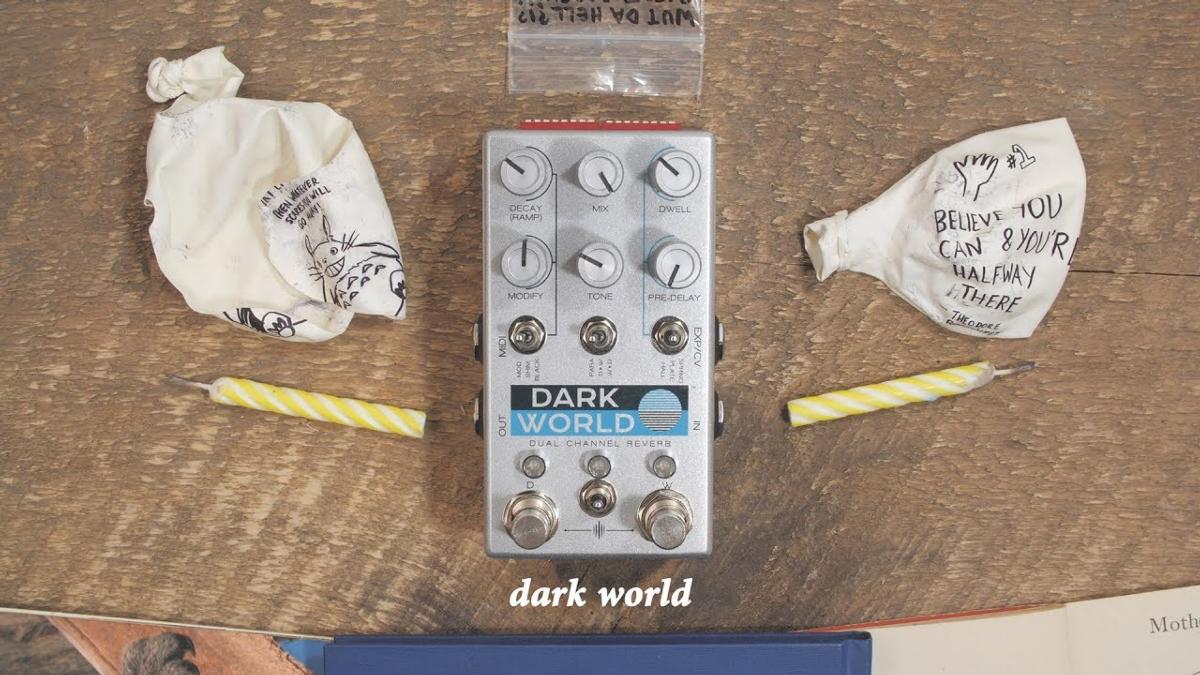
This is a Triple Pedal Masters Collaboration between Joel Korte, Robert Keeley, and Tom Majeski of Cooper FX. Robert supplies the classic right-channel 'World Side' Reverb algorithms, while Tom provides the more textural and interesting left-channel 'Dark Side' Reverb algorithms with the Mod and Black modes somewhat based on Tom's Generation Loss and Outward pedals respectively. I've already said all that needs to be said on this pedal - I've been meaning to get it for a while but have been way-laid by other priorities and missions.
This is a really cool textural reverb and it really comes into its own when you cleverly mix the output of both those channels and adjust their stacking - each way series or parallel.
The 6 Reverb algorithms are:
- Dark Side - Mod | Shim | Black
- World Side - Hall | Plate | Spring
And controls include - Decay/Ramp | Mix | Dwell | Modify | Tone | Pre-Delay | Mod/Shim/Black | Para/D>W/W>D | Hall/Plate/Spring - you also have a footswitch on/off per channel. What makes this a 'Glitch' pedals is obviously Tom's input here - which you can choose how much you utilises, or else just deploy this as a rather standard traditional Reverb - which would be a bit of a waste. This was a really intriguing pedal when first launched, but the MOOD, Generation Loss and Blooper have somewhat overshadowed it of late.
Chase Bliss Audio / Cooper FX Generation Loss VHS Tape Degeneration/Chorus Effect - £349

I always liked the idea of the VHS Tape Degeneration / Decay algorithm of the original Cooper FX Generation Loss pedal, but was not overly enamoured with the form factor. So as a sort of mini follow-up to the Dark World collaboration which already featured a flavour of the Generation Loss - Joel Korte did his own take on new best friend Tom Majeski's original pedal. The new evolution involved Parallel Wet level control and a whole new level of Chorusing which with the usual dip-switch / ramping features tweaked and improved most of the best aspected of the Generation Loss.
This was a 1000 unit limited run which I was delighted to be in on - as I finally had the Generation Loss pedal in my favourite CBA Compact Enclosure form-factor. I would be happy to see all manner of favourite pedals re-made within that enclosure and control-topology. In any case this is a wonderful textural pedal which provides all manner of unique eerie and otherworldly sounds - including a whole load of Lo-Fi style Choruses / Modulations. I really rather like this pedal and it pushed the MOOD aside on that pedal-chain slot rotation!
The other innovation here is the addition of Auxiliary Channel modifiers - Mod/Gen/Filter which can be activated by the left-hand Aux foooswitch - this is a true classic of its type made even better!
Controls include : WOW | Wet/Ramp | HP | Flutter | Gen | LP | Aux Func - Mod/Gen/Filter | Dry (Chorus) - None/Small/Unity | Hiss - None/Wild/Ready
Chase Bliss Audio MOOD Micro Looper - £349
This other Triple Pedal Master Collaboration - with Old Blood Noise Endeavors and David Rolo in the mix shares some superficial similarities with the Dark World in that you have two mixable channels of 3 algorithms apiece with Old Blood Noise Endeavours supplying the left-hand time-based modifiers of Reverb/Delay/Slip - while Granular Delay/Synthesis master David Rolo of Drolo fame supplies the right-hand time-based modifiers - Envelope/Tape/Stretch - both sides sit on top of an 'always listening (recording)' Micro Looper which captures and loops specified lengths or buffers of signal - and you can then affect the loop size, individual grain size - and how the various modifiers interact.
This pedal is pretty much the essence of Glitch - which many have struggled with to figure out specific patterns of behaviour. While this is largely just a learning curve - where you need to move the dials around expansively and note down where you hit the sweet-spots. Fortunately, as on all CBA pedals you have at least two onboard presets to capture those magical interactive settings for posterity. This is a little like EQD's Rainbow Machine but more complex - in that you all of a sudden come across sweet-spots of magic and wonder - which may be tricky to replicate if you had to dial them in a second time around.
Note that most of Chase Bliss's Glitch pedals require extensive due diligence and 'experimentation' to get the best out of them!
Controls include : Time | Mix | Length | Modify | Clock/Sample Rate | Modify | Reverb/Delay/Slip | Mode - Input Only/Input+Looper/Looper Only| Env/Tape/Stretch. And similarly to the Dark World each site's footswitch activates whichever algorithm is selected on that Channel!
Drolo Molecular Disruptor V3 Granular Synthesis / Multi-FX - €260
The V3 Molecular Disruptor is the Glitch pedal I've spent the most time with this year - almost a solid month pretty much. I really ran the full range of all 8 dials across each of the 16 algorithms here - making copious notes throughout on all the different outcomes - the sweet and the ugly spots. It has to be said that with the feedback component in particular on these sorts of pedals you need to be careful how you apply each of those parameters as you can easily get horribly dissonant sounds that beyond shock and surprise serve no particular usable purpose. On several algorithms you also need to adjust parameters in tandem - with small tweaks needing corresponding adjustments elsewhere. Some of these algorithms really took an eternity to understand and dial in - and I realised then that what I really needed here over and above everything else was presets.
In fact how these pedals should be set up is a little like the recent Mooer E7 series - but with 16 presets or one for each algorithm - which are already set to sweet-spots, but which you can then dial in further and save to your own specific preferences.
Another thing I discovered with this pedal is that these 'always-listening' (always recording) Granular / Micro Looper pedals can significantly colour your signal chain - and you of often have to turn back Wet and Dry volumes to stop incidental 'leakage'.
The Molecular Disruptor includes 11 Controls - smplrt | fdbk | wet | dry | PS - PS Footswitch P0 Param Override | P0 Main Parameter | P1 Secondary Parameter | P2 Tertiary Parameter | Bank 1/2 | Modes : 0-7 | Trails Off/On.
With PS Footswitch and On/Bypass Footswitch.
The 16 algorithms I have across the two banks are as follows:
MODULE / BANK 1
- Glitcholay
- Granpa's Vinyl (lo-fi crackles)
- Pitch-Glitcholay
- Pitch Square LFO
- Pitch Step Glider
- Step Filter Bit Crushed
- Stretcholay
- Tannhauser Gate (Bitcrusher/Pitch-Shifter/Filter/Reverb)
MODULE / BANK 2
- Drones
- Enveloop Vibrato
- Reversolay
- Envelope Filter Ring Modulated
- Hold Aliaser
- Hounds Synth
- Particolay
- Tape Loop
You can select algorithms from a list of circa 35 currently which David will consult with you on upon acquisition. I tried to select the weirdest most glitchy modes available! But you can send your module chips back for re-programming to David or else buy further ones for swap-out. The Molecular Disruptor is in many ways very similar to the Pladask Elektrisk Fabrikat - very much occupying that same sort of space although there are differences in algorithms and approach - and both could very obviously do with presets as mentioned several times here.
Hexe reVOLVER DX Micro Looper/Stutter/Glitch - €375
You still see this formidable pedal on a number of pro pedalboards, including in the rare Deluxe DX-L edition of which there is currently one on sale on Reverb.com for a very hefty £1,250. Piotr Zapart has a healthy waiting list for his highly sought-after pedals while most of his pricing isn't totally out of reach - typically around €400 or so.
I can't decided which of his two most popular pedals I prefer more - this or the BitCrusher - and as a result I've acquired neither to date but still sort of intend to get both - just not sure in which order. The overall simplicity of the control topology does rely on using the footswitches to change modes, and while this has only half the number of modes of many of these others - they are all highly usable - while subject to the same whims of tweaking and dialling-in.
The controls are relatively simple with 5 dials for - Tone, Fade, Time, Effect Level and Speed, and a Dry on/off switch. You get dual footswitches On/Off and Capture - and you hold down the former to switch / step through the 8 available modes:
- Glitch : momentary 'Capture' footswitch action
- Speed Up/Slow Down
- Ping-Pong : play direction is flipped at the end of the sample
- Random Direction : play direction is flipped at random points
- Random Auto : pedal re-triggers itself at randomized rate
- Auto : automatic self re-trigger at a constant rate
- Stop - 2x : Halt / half speed - variable speed from 1 octave down (/2) through normal (dead zone) to 1 octave up (2x)
- 1x - Reverse : special mode for reverse effect. The speed goes from normal (1x) to 2 octaves down (/4), in the middle position the play direction is reversed, then the speed increases to normal (1x), still in reversed direction
The King Of Gear Mini Glitch Pedal (Stutter) - c£165
This was my first proper glitch pedal acquired - and in most ways the simplest of those featured here. It has 3 modes:
- RND (Random) : random glitch / stutter
- TRSH (Threshold) : starts new glitch sequence each time input signal threshold exceeds limit set by alt function on main dial
- SW (Switched) : random glitch / stutter activated by momentary or latched footswitch
There are also 3 alt functions 1 per mode, accessed by holding down the footswitch while using main dial
- Rnd Freq : frequency of glitch (RND)
- Offset : threshold level (TRSH)
- Rnd Max : max sample length (SW)
I rather admire the neatness of this pedal - which is a significantly simplified version of its 'Feral' predecessor and manages to cleverly combine the latching and momentary functions into the one single footswitch. It's still well worth seeking out and delivers a somewhat different proposition to my other recommenced Glitch gateway pedal - the Banana Effects Mini Mandala!
Montreal Assembly Count to Five Granular Delay - $250
This was the very first Glitch pedal I had my sights set on, but I somehow ended up getting The King of Gear Mini Glitch Pedal first - it just materialised on Reverb.com at the right time. I seemed to keep missing the official Montreal Assembly releases, but also wasn't paying particular attention to Reverb.com at the time either. In any case once I made a concreted effort to obtain a Count-to-Five I had one pretty much within a week.
This is another still fantastic Glitch gateway pedal which I thoroughly recommend to all - you still see tonnes of these on boards - and what they do they do so well. It's been somewhat overshadowed by more feature-extended and advanced pedals of late - yet it can certainly hold its own.
You have a Mix dial up top, and then 3 parameter dials - the first of which 'Direction' is constant for all modes, while the latter 2 change function depending on mode, we then have 3 toggle switches - M for Mode, Q for Quantization and E for Expression Pedal Assign:
- M = 3-way mode toggle
- Q = up-down toggle for 6 Quantizations - No Quantization, Chromatic Quantization, Whole Tone Scale Quantization, Diminished Triad Quantization, Augmented Triad Quantizaiton, Perfect Fifths and Octaves Quantization
- E = 3-way Expression Pedal Assign Toggle - Mode 1 (Direction, Length of Buffer, Feedback), Mode 2 (Direction, Length of Sample, Randomisation), Mode 3 (1, 2 or 3 read heads)
The 3 modes are as follows:
- Mode 1 - Delay : Direction & Speed of Read Head, Length of Buffer, Arount of Feedback
- Mode 2 - Slicing Looper (4 secs) : Direction (pitch, speed, direction), Length of Sample, Degree of Randomness
- Mode 3 - Layers (8 secs) : each of 3 main parameter dials controls 'Direction' per Top, Middle and Bottom
The right hand footswitch is known as the hard footswitch / ByPass, the left is the soft footswitch / trigger and alt mode selector as referenced in the manual / guides.
MWFX Judder (Stutter) - £250
MWFX is one Somerset native Matt Warren who has dropped somewhat under the radar of late, but used to be one of the rising stars of glitch with his slightly hard-to-handle but still essentially satisfying Judder effect. It is available in three different editions, original medium enclosure Steel or Wood, and reduced-functionality Mini (Compact) edition.
Some of these pedals have had production difficulties along the way as there is a degree of variability in several of the key components, where some circuit components just turn out to be too unstable for long-term use. So I would ask everyone to be patient in their dealings with Matt - as the pedal will materialise eventually, even though there are some unforeseen delays, and Matt is not always the best communicator as such.
This is essentially a stutter effect at heart but with LFO and Envelope Filtering for enhanced modulation and sort of warbly texturisation. Part of me feels that all Glitch-type pedals need a specific 'Randomization' button which this one does not yet have - possibly future editions will have - which randomly mix up the effects and modulations.
5 Dials :
- HOLD : Feedback, Number of Repeats
- LPF : Low Pass Filter / Tone of Echo
- MIX : % Dry to Were Ratio
- LFO/ENV (: LFO Speed / Envelope Sensitivity
- 1/4 BPM : Length of Repeat with BPM Guide
5 Toggle Switches :
- EFFECT: Layer/Judder/Stutter (Sound on Sound or Killswitch Modes)
- MOD : LFO/Envelope Modulation of Sample Length / Pitch
- RANGE : Short/Long Sample Modes
- LFO/ENV : LFO or Envelope Controls
- AUTO : Turns on LFO/ENV Control of Footswitch
2 Footswitches:
- Lock : Latching / Direction of Tap Switch
- Tap : Momentary
Pladask Elektrisk Fabrikat Granular Synthesizer / Sample Playback - $300
There's something in Norwegian water as both Knut of Pladask Elektrisk and Daniel of Fjord Fuzz are somewhat restless innovators and prototypers - sometimes collaborating, but often delivering multiple different versions of the same pedal within the same year.
I was fortunate to win the first Fabrikat lottery in December 2018 to be invited to acquire one of then I guess V2 or V2.5 versions pictured above, as the latest V3 version looks somewhat different with simpler controls for banks / algorithms, with a loss of the former L.SW or left footswitch mini knob. In fact there used to be 5 regular size knobs including mode selector, with 4 mini knobs (L.SW | Feed | EQ | Vol) - while on the latest edition we are down to 8 all regular knobs with all the same parameters and functions as before - or P1 | P2 | Volume | Mix | Feedback | Loop | EQ.
The one other difference being that with the change of the Mode dial, and no longer need for a B1/B2 toggle, we instead have a Loop/Infinity Toggle Switch.
The 16 Modes / Algorithms however remain the same as before, also per the first two banks of the more expansive FORM2 pedal.
- 1.1 Time Stretch with Buffer Size
- 1.2 Time Stretch with Pitch Shifting (1000 ms buffer)
- 1.3 Time Stretch with Grain Size (1000 ms buffer)
- 1.4 Time Stretch Pendulum with Grain Size (1000 ms buffer)
- 1.5 Time Stretch Random Pendulum (1000 ms buffer)
- 1.6 Freeze/Scrub with Spread (1000 ms buffer)
- 1.7 Freeze/Scrub with Pitch Shifting (1000 ms buffer)
- 1.8 Beat Repeater (1000 ms buffer)
- 2.1 Sample Playback – 1 Head Manual Sweep
- 2.2 Sample Playback – 1 Head Octave Steps
- 2.3 Sample Playback – 2 Heads Manual Sweep (1000 ms)
- 2.4 Sample Playback – 2 Head Octave Steps (1000 ms)
- 2.5 Sample Playback – 1 Head Random Octave/Direction
- 2.6 Shuffle Delay
- 2.7 Shuffler
- 2.8 Shuffle/Mask (250 ms)
There are some superficial similarities here to the Drolo Molecular Disruptor while I find the Fabrikat somewhat easier to dial in overall, but it could still really do with presets!
PLBR Effects Pizzacrusher Bitcrusher Glitch Fuzz - discontinued - €149
This pedal actually started out as more of an intentional sort of randomized arcade noise style cleanish bitcrusher before Darko of PLBR Effects decided to add the Square Wave Fuzz element to it - and I'm all the more grateful for it! As it ends up a sort of 3-way between Bitcrusher, Glitch and Fuzz.
Of the 7 controls, 2 are for the Bitcrusher - Crush (Resoltution) and Sample (Rate), the Glitch is a 3-way 1/2/3 Glitch Pizza Modes toggle which interacts with the Speed, Tone and Volume Dials; while the Sinewave to Square Wave toggle-switch activates the Fuzz in the Square position.
The 3 Glitch / Pizza Modes are:
- Crush and Speed Modulate Randomly
- Crush Arpeggiates Up/Down, Speed controls Rate of Arpeggiation
- Crush Modulates Randomly, Speed is Fixed
On second thought - this is the simplest pedal to dial in here and surely the ideal gateway pedal to Glitch - albeit the randomised glitching is not a complex as many of these others, but still yields very satisfying yet only marginally quirky sounds!
Red Panda Lab Particle V2 Granular Delay / Pitch Shifter - £189
And so to the Red Panda Particle V2 which is really the one that is easiest to recommend here in many ways - as it's limited controls and onboard presets make it really learnable and very practically usable in most ways.
It's also a benefit that you're mostly only dealing with effects across two vectors - with 5 Delay modes - Density, LFO Time Stretch, Reverse, Pitch and Random, and 3 Pitch modes - Density, LFO Modulation and Detune/Randomization.
The 5 parameter dials - Blend, Chop/Freeze, Delay/Pitch, Feedback and Parameter are also all very straightforward - with Blend, Delay and Feedback working just like your standard typical simple 3-knob delay pedal. Chop adjusts the Grain Size through to Freeze Threshold.
While the changing Param values per the 8 modes are as follows:
- Grain density (interonset time)
- Stretch/compress ratio (LFO speed)
- Direction probability
- Pitch shift amount
- Time randomization range
- Detune amount
- LFO speed
- Grain density (interonset time)
I of course think it could do with 8 presets like the Wamper Terraform - and you could then preload an idealised / optimised version of each mode for the user to tweak further.
Also the dual footswitches should work with simultaneous press - so by hitting both footswitches at the same time you can page up through the Presets! Otherwise it's a major step forward in every way from the Particle V1.
Red Panda Tensor Looper/Time Stretcher/Pitch-Shifter - £189
This was on lots of 'Best of' lists for 2018, and a firm favourite of TPS Daniel Steinhardt amongst others. This sort of Tape-style Tape-Stretch Pitch-Shifting Randomizing time-based Modulating effect certainly has legions of fans and I was at one stage on the cusp of acquisition - before other priorities pushed it aside.
The Randomization knob is certainly a key factor of the Glitch here - I feel that Glitch is largely a by-product of random behaviours and processing errors essentially. You have 5 knobs at your disposal - Tape Speed | Time Stretch | Pitch Shift | Wet/Dry Blend | Ramdomization - working across 2 modifiers - Hold (Looping) and Direction.
For HOLD (Loop) you have 3 modes :
- OVR - Overdub (sound on sound)
- REC - Record (replace)
- NXT - Next (dual buffer)
And for DIR (Loop Direction) you have 3 modes :
- FWD - Loop plays forward
- ALT- Loop alternates between forward and reverse
- REV - Loop plays in reverse
You then have M (Momentary) / L (Latching) toggles for each of HOLD and ON footswitches.
I personally would like to see some onboard presets here like on the later version Particle V2 - also activated by dual-footswitch simultaneous press - otherwise the Tensor is pretty perfectly formed too.
Right here and now - this is possibly the least likely acquisition targets in the current listing as I'm sort of holding and waiting to see what happens in this area.
SSD Devices Atom Smasher Glitch Delay - discontinued - £180 when new
I'm not sure how I overlooked this at the time - I was aware of SSD's EVA Fuzz and acquired one such later, and considered the Trans_Mission Killer Distortion too, but somehow the equally impressive Atom Smasher evaded my radar - as I wold undoubtedly have snapped one up had I been aware.
This is essentially an 8-Mode Glitch Delay / Reverb Pedal (plus POG!) which was made in several small batches mostly around 2017 - with the 3 changeable Parameter dials variously labelled Var 1-3 ( as above) or Ctrl 1-3 - while to make things more confusing the actual 8-Mode selector was labelled either Ctrl (as above) or Mode. Besides that you had a commonly labelled 'Mix' (Dry-Wet) knob and a hidden / covered secret switch for purely cosmetic purposes on this occasion!.
There are two footswitches - the right-hand 'Engage' one Latching, and the left hand unlabelled one a Momentary max-out of Parameter 1 - with the corresponding LED reflecting the degree of that.
The 8 Modes covered are:
MODE 1 = Stutter
- Param 1 = Footswitch Responsiveness
- Param 2 = Buffer Length of Stutters
- Param 3 = N/A for Mode 1
MODE 2 = Glitch
- Param 1 = Rate of Frequency of Glitches
- Param 2 = Size of Grains
- Param 3 = Degree of Randomization of Grain Size
MODE 3 = Reverse Ramp Delay
- Param 1 = Ramp Speed
- Param 2 = Degree of Ring Modulation
- Param 3 = Delay Pre-Distortion
MODE 4 = Dual Pitch Delay
- Param 1 = Delay Loop Feedback
- Param 2 = Delay Time for Pitch-Shifted Delay
- Param 3 = Delay Time for Dry Delay
MODE 5 = Pitch Shift (POG-style)
- Param 1 = Internal Wet/Dry Mix
- Param 2 = Mix of Pitch-Shifted Upper Octave
- Param 3 = Mix of Pitch-Shifted Lower Octave
MODE 6 = Reverse Quantizer
- Param 1 = Level of Quantizer
- Param 2 = Mix of Quantizer
- Param 3 = Reverse Delay Cross-fade
MODE 7 = Pitch Shift Reverb
- Param 1 = Depth of Reverb
- Param 2 = Degree of Pitch-Shifted Reverb
- Param 3 = Wet/Dry Mix
MODE 8 = Revere Reverb
- Param 1 = Degree of Pre-Delay
- Param 2 = Reverb Decay Time
- Param 3 = Reverb Signal Damping
Now that this one is firmly on the radar I'm already on a hunt for such - hopefully Mr SSD Devices will be motivated to get stuck in again eventually!
Tomkat Pedals Cloudy Digital Multi Effect Pedal - $385
I've rarely spent quite so long a time in actively chasing a single pedal - yet it pretty much took me from early March until the end of November to finally secure one of these. I totally missed the initial announcement and very first batch of the year - in fact only clocking onto the Tomkat Cloudy when I came across Devon Blue Whitaker's amazing above referenced YouTube demo.
I then jumped on the mailing list and was all prepped and set to snatch one of the April batch versions - but for whatever reason the Tomkat site just wasn't playing ball - and I could not get the Add to Basket button to activate - so I sort of missed out on that too.
Tom Kogut then decided to take pre-orders at the end of May (28th) with a view to fulfilling orders around 10-12 weeks later. Yet for whatever reason - I have a feeling there was a continuous process of manufacturing improvements going on - and despite persistent chases for updates, the pedal did not turn up until the Friday 29th of November - almost 6 months to the day from the point of purchase!
In fact with the other priorities and projects I took on in the meantime - I've not really had time to fully check out the Cloudy yet - beyond a quick run through of each of its six modes:
- Granular Processor
- Pitch Shifter/Time Stretcher
- Looping Delay
- Spectral Madness
- Emmiverb
- Resonestor
Which are controlled by 6 Regular Knobs - Size, Pitch, Density, Position, Mix, and Texture; along with 5 smaller Mini Knobs - Output Level, Stereo Pan, Verb (Re-), Feedback, and Input Level - or 11 controls all told.
Further to this you have two push-button switches also - the left hand one changes down the signal quality from High Quality Stereo to High Quality Mono, Low Quality Stereo and Low Quality Mono - or a buffer size from 8 seconds down to 1. You also have dual footswitches with the left-hand one activating a Freeze/Hold function.
This is obviously Tom Kogut's excellent take on Mutable Instruments EuroRack version 'Clouds' Granular Audio Processor - with a few more concessions thrown in, but it also retains CV inputs on the side of the pedal to underline its Rack-roots!
As with most of the other pedals here the named knobs can cover a variety of functions based on the Algorithm / Mode selected - so it's not a pedal you can really operate without a manual! Based on all the demos I've seen - this is capable of some fantastic 'Glitchy' tones - but considering how many Glitch pedals I now have - there is always some slight degree of overlap - I'm kind of glad though that this only the penultimate Glitch pedal to arrive before year-end!
Final Thoughts and Recommendations
What has actually been most fun for me in this process is really finding out the similarities between these various pedals, there mostly shared flaws and challenges, and seeing how Chase Bliss Audio has pretty much come from nowhere to be a fairly dominant player in this category. I've been following Chase Bliss Audio from their earliest Analog Modulation days, and then their shift into Gain Pedals and Delays, and then what looked like Reverb, but was actually the first of 4 somewhat connected Glitch pedals - with certain elements providing a seamless connection from one to another - right up to the most recent Blooper pedal - which most American customers have received already by now, and we Brits should be getting our hand on this week.
A common weakness with a lot of these pedals is the need to consult a manual, as well as the often very significant interactivity of multiple dials - whose variables change per Algorithm - and which occupy wholly different starting positions for each Algorithm. This means that certain variables you are best off with starting full counter-clockwise or fully clockwise - rather than at the more typical noon or 2 o'clock position even.
There's no question that many of these pedals take a lot of patience and dedication to get maximum returns - sometimes even just to hit fully usable tones - and along the way you will encounter all manner of random and unusual behaviours!
It's obvious that the Granular Delay / Granular Synth genre is still very much in its infancy - and at one stage I was thinking of including the Zoia here too - which with some of its more recent parameters - including randomisation - most certainly has a very significant 'Glitch' component to it, but that pedal is really in a lofty category all by itself, and I'm nowhere near getting fully to grips with mine - which I believe is widely the case.
For Glitch to be universally accessible the format really needs pedals with presets for each of the algorithms - so you can at least start from a strong / optimised starting position - rather than having to play mostly 'go-fish' for useful tones. Sometimes this can be a fun afternoon's worth - but it's rarely as much fund the second or third time around where you're finding it hard to dial in those sweet-spots - even with the most detailed of notes!
So 3 of the Chase Bliss Audio pedals are kind of your starter for 10 - with 2 onboard presets, next comes the Red Panda Particle V2 with 4 onboard presets, and then the Blooper - with a very impressive 16 scrollable onboard presets - yet most of these won't work fully satisfactorily without midi.
There are many aspects of the Red Panda Particle V2 that are nigh perfect - but it really should have 8 pre-defined presets to match its algorithms, and you should be able to simultaneously press the two footswitches to page up through the presets.
I see a point in the future where bigger companies like Boss and Strymon might be producing their own Glitch / Granular / Pitch-Shifting Workstation pedals in larger formats - with banks of easily selectable, and more easily accessible and replicable settings. Sure you can already achieve amazing tones - but boy can it take a lot of effort - and it can be so hard to replicate or engage even at the moment. I look forward to a time where all this has been distilled and refined to a point of easy adoption! For now - enter with caution - and be prepared as to what is expected of you - otherwise you will be selling several expensive pedals a few months down the road because you haven't properly connected or bonded with them!
In terms of where I am in the process - I feel I've got to grips with some of these, but by no means all, and nowhere near as fully as I have with other highly complex pedals. I will certainly be acquiring a few more here - including the Banana Effects Mandala, Chase Bliss Audio Dark World and SSD Devices in the first wave. Leaving me with the Hexe reVOLVER and Red Panda Tensor to hoover up later. I don't really necessarily need any more, and I rarely have more than one operational within my chain at any given time - I still need to decide though which is truly the perfect one for me - and whether that moment has already arrived or is still to come. I may also snap up some of the others covered previously if I come across appealing examples and favourable prices as usual (e.g Dwarfcraft Grazer) - but then again this is not necessarily one of my major areas of pedal engagement and I have a lot of other priorities besides - so in all likelihood I will probably call this selection fully representative after a couple or so additions and then move onto something else! Unless of course Joel Korte keeps pumping these out - in which case I'm still on the hook ...











